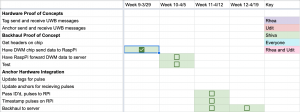We finalized handing all the hardware we had over the Shiva and ordering more of our final hardware from Quinn to Shiva. He was able to use UART to export data from decawave radio into RPi (no longer need SPI since hardware requirement are lessened). He can now read data into the RPi and timestamp.
Shiva has MANY tests to run and data to collect. First he will use a stationary tag and stationary anchor to measure various errors and reliability. We want to see the difference between theoretical pulse transmission time differences and the differences in reception. We want to measure both the precision of the reception differences as well as the absolute difference between it and the transmission as an offset in our server code. We want to also do these tests by first timestamping in the Decawave chip and then in the raspberry Pi to see if we see which measure is more reliable. He can move on to looking at reliability with 1 stationary tag and 2 anchors and test differences in Non-LOS settings.
These experiments will be used to validate the the simulated error we will add to the hardware simulator program. If our simulator has the same percent errors as Shiva reports, we can safely validate our simulator as a way to scale our project and test the success of our Kalman smoothing and Gauss-Newton approximator.
Rhea and I have been precisely been researching and implementing those just mentioned algorithms.
We hope that we can have a basic demo with Shiva’s error graphs + Udit ideal simulation + Gauss-Newton localization by Wednesday.

